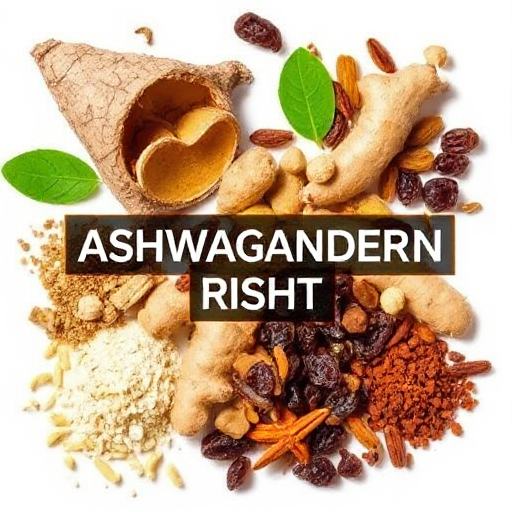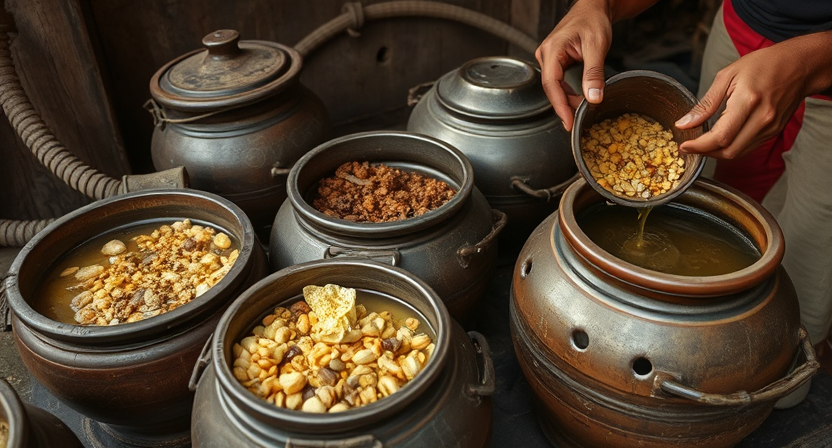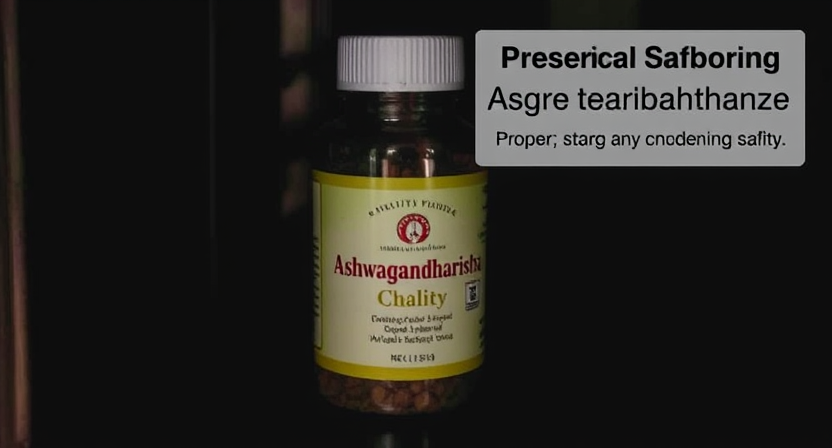Ashwagandharishta: Introduction
Ashwagandharishta, a traditional Ayurvedic liquid formulation, holds a significant position within the ancient Indian system of medicine. Classified as an arishta, it is a self-generated alcoholic preparation made through a process of fermentation. This specific formulation is highly valued for its adaptogenic, nervine tonic, and rejuvenating properties.

Ashwagandharishta is not merely a simple herbal mixture; it represents a complex combination of natural ingredients, each carefully selected and combined to achieve particular therapeutic outcomes. This article will explore Ashwagandharishta in detail, covering its composition, traditional uses, dosage guidelines, potential side effects, required precautions, and relevant modern perspectives, offering a balanced and comprehensive overview.
Table of Contents
Top 10 Benefits and Uses of Ashwagandharishta
| SN/Content | Benefit/Use | Description | Ayurvedic Principle/Basis |
| 1 | Reduces Stress and Anxiety | Acts as an adaptogen, helping the body cope with stress, reducing anxiety, and promoting a sense of calm and well-being, balances Vata and nourishes Majja dhatu. | Action of Ashwagandha and other herbs, balances Vata, promotes mental clarity, enhances Sattva. |
| 2 | Improves Strength and Stamina | Acts as a tonic, enhancing physical strength, endurance, and overall vitality, supporting muscle development and reducing fatigue, nourishes all body tissues especially Mamsa and Shukra dhatu. | Brumhana (nourishing) and Balya (strengthening) properties of Ashwagandha and other herbs, improves Ojas. |
| 3 | Enhances Cognitive Function | Supports cognitive function, improving memory, concentration, and mental clarity, and enhances learning by improving focus. | Medhya (intellect-promoting) properties of certain ingredients like Ashwagandha, improving Dhi, Dhriti, and Smriti. |
| 4 | Promotes Rejuvenation (Rasayana) | Acts as a Rasayana, promoting longevity, vitality, and overall rejuvenation by enhancing Ojas (vitality) and supporting cell regeneration. | Rasayana effects of Ashwagandha, Amalaki, and other ingredients; supports Dhatu and overall health. |
| 5 | Improves Sleep Quality | Promotes better and deeper sleep by reducing stress and anxiety, and calming the nervous system, thereby improving sleep quality and managing insomnia. | Vata-balancing and Shamak (calming) properties of ingredients. |
| 6 | Supports Nervous System Health | Supports the overall health of the nervous system, reducing nervous weakness, improving nerve function, and reducing tremors and fatigue. | Nervine Tonic action of Ashwagandha, balances Vata, reduces nervous irritation and fatigue. |
| 7 | Enhances Sexual Health | Improves sexual strength and stamina, promotes fertility, and may also improve overall sexual well-being. | Vrishya (aphrodisiac) properties of Ashwagandha, also helps improve vigor and vitality. |
| 8 | Improves Digestion | Digestive spices help stimulate digestive enzymes, reduce bloating and gas, improve appetite, and promote better digestion and absorption of nutrients. | Deepana (appetizer) and Pachana (digestive) actions of ginger, pepper, and other digestive herbs. |
| 9 | Improves Immunity | Supports and strengthens the immune system, improving the body’s resistance to common infections due to immunomodulating properties. | Immunomodulatory effects of Ashwagandha, Amalaki, and other herbs. |
| 10 | Supports Overall Well-Being | Promotes a general sense of well-being, improving energy levels, reducing fatigue, promoting vitality, and helping in the overall rejuvenation of the body by nourishing all the body tissues. | Balances doshas and promotes overall health, enhances Ojas and vitality. |
Important Notes:
- Traditional Perspective: These benefits are based on traditional Ayurvedic principles and practices.
- Individual Variation: The effects may vary depending on individual Prakriti, health condition, and other factors.
- Not a Primary Treatment: It is often used as a supportive remedy, not a primary treatment for severe conditions.
- Professional Guidance: Always consult a qualified Ayurvedic practitioner or healthcare provider before use.
- Modern Research: Modern scientific studies are limited, and effects are primarily based on traditional use and the known properties of individual ingredients.
Ingredients: The Composition of Ashwagandharishta
Ashwagandharishta is a meticulously formulated preparation, comprising various herbs, spices, and other natural components working synergistically to achieve its beneficial effects. Here is a detailed list of its primary ingredients, along with their common names, botanical names, and their traditional Ayurvedic properties:

| Ingredient (Common Name) | Botanical Name | Ayurvedic Properties (Rasa, Guna, Virya, Vipaka) | Purported Role in Formulation |
| Ashwagandha (Winter Cherry) | Withania somnifera | Tikta, Katu, Ushna, Laghu, Madhura | Adaptogen, nervine tonic, rejuvenative, reduces stress and anxiety, improves Sexual strength and stamina |
| Draksha (Raisins) | Vitis vinifera | Madhura, Guru, Sheeta, Madhura | Base for fermentation, nutritive, improves palatability and digestion |
| Dhataki Flower | Woodfordia fruticosa | Kashaya, Ruksha, Sheeta, Katu | Facilitates fermentation, imparts color, contains tannins |
| Musta (Nutgrass) | Cyperus rotundus | Katu, Tikta, Ruksha, Sheeta, Katu | Digestive, carminative, anti-inflammatory, helps in reducing fever |
| Haritaki (Chebulic Myrobalan) | Terminalia chebula | Tikta, Kashaya, Ruksha, Ushna, Madhura | Digestive, laxative, detoxifier, rejuvenative, promotes overall health |
| Vibhitaki (Belleric Myrobalan) | Terminalia bellirica | Kashaya, Tikta, Ruksha, Ushna, Madhura | Supports digestion, expectorant, rejuvenative, balances Kapha and Pitta |
| Amalaki (Indian Gooseberry) | Emblica officinalis | Amla, Madhura, Sheeta, Laghu, Madhura | Rich in Vitamin C, antioxidant, rejuvenative, immunomodulatory, supports overall well-being, balances Pitta |
| Shunthi (Dry Ginger) | Zingiber officinale | Katu, Ushna, Guru, Madhura | Digestive, carminative, anti-inflammatory, reduces pain and bloating |
| Maricha (Black Pepper) | Piper nigrum | Katu, Ushna, Laghu, Katu | Digestive, enhances the bioavailability of other herbs |
| Pippali (Long Pepper) | Piper longum | Katu, Ushna, Guru, Madhura | Digestive, carminative, expectorant, supports respiratory health |
| Vidanga (Embelia) | Embelia ribes | Katu, Ushna, Laghu, Katu | Anthelmintic, digestive, reduces bloating and gas |
| Ela (Cardamom) | Elettaria cardamomum | Madhura, Laghu, Sheeta, Madhura | Digestive, carminative, improves taste, enhances nutrient absorption |
| Tejpatra (Bay Leaf) | Cinnamomum tamala | Katu, Ushna, Laghu, Katu | Digestive, carminative, anti-inflammatory |
| Twak (Cinnamon) | Cinnamomum zeylanicum | Katu, Madhura, Ushna, Katu | Digestive, carminative, improves circulation |
| Nagkesar (Mesua ferrea) | Mesua ferrea | Tikta, Kashaya, Laghu, Ushna, Katu | Astringent, anti-inflammatory, reduces excessive bleeding, supports digestive function |
| Guda (Jaggery) | Saccharum officinarum | Madhura, Guru, Ushna, Madhura | Sweetening agent, base for fermentation |
Understanding Ayurvedic Properties
The Ayurvedic properties (Rasa, Guna, Virya, and Vipaka) are critical for understanding the action of each ingredient and the overall therapeutic profile of Ashwagandharishta:
- Rasa (Taste): The basic taste of an ingredient, for example, Madhura (sweet), Katu (pungent), Tikta (bitter), Kashaya (astringent), Amla (sour), or Lavana (salty).
- Guna (Qualities): Describes attributes such as Guru (heavy), Laghu (light), Sheeta (cold), Ushna (hot), Ruksha (dry), or Snigdha (unctuous).
- Virya (Potency): The heating or cooling effect of the ingredient on the body.
- Vipaka (Post-Digestive Effect): The taste that develops after digestion, which can be Madhura, Amla, or Katu.
These properties guide the selection and combination of herbs in Ashwagandharishta, aiming to balance the doshas and restore overall health. The formulation is particularly focused on enhancing Ojas (vitality), reducing stress, and improving strength.
Source and Quality of Ingredients
The effectiveness of Ashwagandharishta is significantly dependent on the quality of its ingredients. Traditionally, herbs are sourced from their native habitats, often collected during specific seasons to ensure maximum potency. Modern practices often involve the use of cultivated herbs, which, if handled correctly, can be just as effective.
However, it is essential to ensure the quality and authenticity of the base ingredients, like raisins, jaggery, and Dhataki flowers. It is essential that the herbs are sourced from reliable sources, and that stringent quality control procedures are adhered to to maintain the efficacy of the formulation.
Traditional Uses of Ashwagandharishta
Ayurvedic texts, including Bhaishajya Ratnavali and Charaka Samhita, describe the traditional uses of Ashwagandharishta. It is primarily known for its ability to:

- Reduce Stress and Anxiety: Ashwagandha is a potent adaptogen, helping the body cope with stress and reducing anxiety levels by balancing Vata dosha.
- Improve Strength and Stamina: It is used as a general tonic to enhance physical strength, endurance, and overall vitality.
- Enhance Cognitive Functions: The formulation is believed to support cognitive function, memory, and concentration.
- Promote Rejuvenation: It is considered a Rasayana, promoting longevity and overall rejuvenation by enhancing Ojas.
- Improve Sleep Quality: It may help in promoting better sleep quality by reducing stress and anxiety.
- Support Nervous System Health: The nervine tonic properties of Ashwagandha, along with other herbs, help support the overall health of the nervous system.
- Improve Digestion: The digestive spices in the formulation help improve digestion.
Ashwagandharishta is often recommended as a supportive remedy for those experiencing stress, fatigue, or general weakness, and during convalescence after prolonged illness. Check out
Primary vs. Secondary Uses
The primary focus of Ashwagandharishta is on reducing stress and anxiety, enhancing strength and stamina, and promoting rejuvenation. Its digestive benefits can be considered as a secondary but supportive benefit.

Modern Perspectives: Limited Scientific Evidence
While Ashwagandharishta is well-known in traditional Ayurvedic practice, there is limited extensive modern scientific research on the combined efficacy of the whole formulation. However, Ashwagandha itself has been studied for its adaptogenic, anxiolytic (anti-anxiety), and neuroprotective properties.
Other ingredients like Amalaki and Haritaki are known for their antioxidant and rejuvenative effects. Further research is required to evaluate the combined effect of the formulation and validate its traditional uses. Much of the existing information available stems from traditional Ayurvedic knowledge and anecdotal evidence.
Preparation Methods
Ashwagandharishta is prepared using a traditional fermentation process:
- Infusion: The herbal ingredients are coarsely ground and added to a solution of raisins, jaggery, and water.
- Fermentation: The mixture is then placed in an airtight container and left to ferment naturally. Dhataki flowers are often added to aid fermentation.
- Maturation: This mixture is allowed to mature for a specific period of time, usually several weeks to months.
- Straining and Bottling: The matured liquid is strained, filtered, and then bottled.
- Quality Checks: Commercial manufacturers follow standard quality control and analysis techniques to ensure the quality of the finished product.
This process produces a self-generated alcoholic preparation with a distinct herbal flavor and the therapeutic properties of the combined ingredients. Due to limited information available regarding proprietary manufacturing process, the above mentioned is generalized information of making aristas.
Dosage Guidelines
Dosage recommendations for Ashwagandharishta are based on age, individual constitution (Prakriti), the health condition being addressed, and digestive capacity. General guidelines are:

- Adults: 10 to 20 ml (2-4 teaspoons) twice daily after meals, or as directed by an Ayurvedic practitioner.
- Specific Conditions: The dosage may need adjustment depending on the specific health issue. Higher doses may be recommended for severe fatigue, stress, or insomnia while a lower dose might be sufficient for general tonic purposes.
Importance of Prakriti
The individual constitution (Prakriti) is considered while prescribing the formulation. Pitta types may need lower doses due to the heating potency of Ashwagandha, whereas Vata types may benefit greatly from it, especially if they have stress and insomnia.
Dosage Forms
Ashwagandharishta is typically available as a liquid for oral consumption. It can be consumed directly or diluted with a small amount of water. Some manufacturers may also offer it in capsule form.
Side Effects and Precautions
While generally considered safe for use, Ashwagandharishta has certain side effects and precautions:

- Digestive Upset: Overconsumption might cause mild digestive discomfort.
- Alcohol Content: It does contain alcohol, which needs to be considered for individuals sensitive to alcohol.
- Allergic Reactions: Allergic reactions to any of the herbal ingredients are possible.
- Drug Interactions: It may interact with certain medications like sedatives and anti-depressants.
- Contraindications: Those with hyperacidity and gastritis must be careful while using this formulation.
- Pregnancy and Breastfeeding: It’s best avoided in pregnancy and breastfeeding without consulting a healthcare professional.
The Importance of Professional Consultation
Consulting a qualified Ayurvedic practitioner before using Ashwagandharishta is essential, particularly if:
- You have existing health conditions.
- You are taking prescription medications.
- You are pregnant or breastfeeding.
- You are unsure about your Prakriti or appropriate dosage.
A practitioner can provide personalized recommendations and ensure safe and effective usage.
Quality and Storage

Always choose Ashwagandharishta from reputed manufacturers who adhere to good manufacturing practices. Store it in a cool, dark place away from direct sunlight and heat, preferably in a tightly sealed glass container. It should be consumed within the expiry date. Any noticeable change in color, odor, or taste indicates poor quality.
Disclaimer
The information provided in this article is for educational purposes only and should not be taken as medical advice. The use of Ashwagandharishta should always be under the supervision of a qualified healthcare professional. Self-treatment without guidance can be harmful.
Conclusion
Ashwagandharishta is a traditional Ayurvedic formulation valued for its adaptogenic, nervine tonic, and rejuvenating properties. While traditional texts highlight its benefits, it’s essential to approach its use with caution, mindful of potential side effects, contraindications, and the presence of alcohol. Consulting a qualified Ayurvedic practitioner or healthcare professional before use is of utmost importance. By taking these precautions, one can safely and effectively utilize the therapeutic potential of Ashwagandharishta.
FAQs About Ashwagandharishta
- What does Ashwagandharishta do?
Ashwagandharishta is a traditional Ayurvedic formulation that acts as an adaptogen, helping the body manage stress. It’s also used as a nervine tonic, to improve strength, enhance cognitive functions, and promote overall rejuvenation. It helps to balance the body by balancing the Vata dosha, and is useful during convalescence. - What are 5 brilliant benefits of Ashwagandha?
Ashwagandha is known for:- Reducing stress and anxiety.
- Improving strength and stamina.
- Enhancing cognitive function (memory and focus).
- Promoting rejuvenation and longevity.
- Improving sleep quality.
- What is the miracle of Ashwagandha?
While not a “miracle,” Ashwagandha’s adaptogenic properties are significant, helping the body cope with stress, reduce anxiety, improve energy levels, and promote overall well-being. It has a wide range of effects on the body by promoting cellular regeneration. - What is Ashwagandha rich in?
Ashwagandha is rich in bioactive compounds, including withanolides, alkaloids, and saponins, which contribute to its therapeutic properties. It is also rich in nutrients that nourish the body. - Is Ashwagandha safe for the liver and kidneys?
Generally, Ashwagandha is considered safe for the liver and kidneys when taken in recommended doses. However, those with pre-existing liver or kidney conditions should consult with a healthcare professional before using it. - Is Ashwagandha OK to take daily?
Ashwagandha is generally considered safe for daily use when taken as recommended. However, it is best to take it in cycles or as directed by a healthcare provider, since the body can develop tolerance to it. It is not advisable to take it indefinitely. - Is Ashwagandha safe for everyone? Who should not take Ashwagandha?
While it is generally safe, Ashwagandha should be avoided by pregnant and breastfeeding women. Individuals with autoimmune diseases, thyroid disorders, and those taking certain medications (sedatives, anti-depressants, hormonal medication etc.) should seek medical advice before use. Those with hyperacidity and gastritis must take it with care. - Is Ashwagandha a steroid?
No, Ashwagandha is not a steroid. It’s an adaptogenic herb that helps the body manage stress and does not have any steroidal structure. - Is Ashwagandha a blood thinner?
There is some evidence suggesting Ashwagandha may have mild blood-thinning properties. Those taking blood-thinning medications should consult their doctor before using it. - Can Ashwagandha cause low platelets?
There is no strong evidence to suggest that Ashwagandha directly causes low platelet counts. However, those with platelet disorders should consult their healthcare provider before use. - Can Ashwagandha cause blood clots?
There is no evidence to indicate that Ashwagandha directly causes blood clots. However, those with blood clotting disorders should exercise caution. It is best to avoid using it prior to surgical procedures. - What are the negative sides of Ashwagandha?
While generally safe, potential side effects include mild digestive upset, drowsiness, or allergic reactions. It may also interact with certain medications. Individuals with autoimmune diseases should be careful using it. - Does Ashwagandha affect the liver?
In rare cases, Ashwagandha has been associated with liver issues. Those with pre-existing liver conditions should consult with a healthcare professional before using it. It is best to take breaks in its consumption to help avoid any adverse effects. - What is the best time to take Ashwagandha?
It is usually taken after meals. It can be taken in the morning to boost energy and during the evening to promote sleep. It is best to consult a health practitioner for the best time for consumption based on individual needs. - Can I take Ashwagandha at night?
Yes, Ashwagandha can be taken at night to help promote sleep by reducing stress and anxiety. - How to consume Ashwagandharishta?
Ashwagandharishta is typically taken orally as a liquid. The recommended dose for adults is 10-20ml (2-4 teaspoons) twice daily after meals or as directed by a healthcare practitioner. It is important to adhere to the recommendations of your physician. - Can we drink Ashwagandha with milk?
Yes, Ashwagandha can be taken with milk. This is a traditional way of consuming it as it may improve the digestion. - Does Ashwagandha work immediately?
No, Ashwagandha is not likely to show immediate effects. It is an adaptogen that works gradually to balance the body. Consistent use over several weeks may show the best results. - Which brand of Ashwagandharishta is best?
The best brand depends on individual preference, but it’s advisable to choose a reputable manufacturer that adheres to good manufacturing practices and quality control. Check for quality certifications. - Can we take Ashwagandharishta at night?
Yes, it can be taken at night to reduce stress and improve sleep quality, however, if it causes any gastric discomfort, it should be taken after dinner to aid in digestion. - Which disease is cured by Ashwagandha?
Ashwagandha is not a cure for any specific disease. It is an adaptogen that helps the body cope with stress and promotes overall well-being. It may provide supportive relief from many conditions but it does not treat any underlying health condition. - Is Ashwagandha good for fatty liver?
While there is no specific evidence of Ashwagandha directly treating fatty liver, its adaptogenic and anti-inflammatory properties could help in overall liver health. Those with a fatty liver should consult with their doctor before its usage. - Can Ashwagandha gain weight?
In some cases, it can promote weight gain by improving appetite and enhancing overall health. However, weight gain is not a primary effect for most users. - What not to mix with Ashwagandha?
Avoid combining Ashwagandha with sedatives, immunosuppressants, anti-depressants, and hormone medications without consulting a healthcare professional, as it might interact with these substances. - How to lower INR naturally?
INR (International Normalized Ratio) should be managed under the supervision of a healthcare provider. Dietary changes may be beneficial, but it is best to consult a physician regarding this. - Does Ashwagandha reduce triglycerides?
Some studies suggest that Ashwagandha may have a positive effect on reducing triglycerides, but more research is needed. - Does Ashwagandha increase oxygen levels?
There isn’t specific research stating that Ashwagandha directly increases oxygen levels. However, through its overall supportive and rejuvenating action it may help enhance respiratory functions. - Does Ashwagandha increase WBC?
There is evidence of Ashwagandha having an immunomodulatory effect which can help enhance the immune system and support healthy white blood cells. - Does Ashwagandha raise BP?
While it is not a primary effect of Ashwagandha to increase blood pressure, there may be minor effects. Those with high blood pressure should monitor their blood pressure while taking it and should consult their doctor prior to using it. - Is Ashwagandha good for the thyroid?
It may be helpful for improving mild thyroid imbalances. However, those with thyroid disorders should take it only under medical supervision as it could interfere with thyroid hormones. - Which supplement is best for hemoglobin?
Iron supplements are typically recommended for increasing hemoglobin levels. Other supportive supplements may be used but it is best to consult a doctor prior to starting any supplements. - What is the best vitamin for fatty liver?
There are a few vitamins that support liver health. B complex vitamins, Vitamin E are among a few. Consulting a health care practitioner prior to taking any supplements is best. - Is Shilajit good for platelets?
Shilajit is not known to have specific effects on platelet count. Those with platelet issues should consult with their doctor before using it. - Is Ashwagandha good for hemoglobin?
While Ashwagandha is not a primary source of iron, it can help improve overall well-being, which may indirectly support healthy hemoglobin levels. - How can I shrink my fatty liver?
A combination of lifestyle changes, including dietary modification, exercise, and weight management strategies can help in managing fatty liver. Always consult with your doctor prior to beginning any regimen. - How to detox thyroid?
There isn’t a specific way to detox the thyroid, however, by eating healthy, reducing stress and improving overall health, it may help support overall thyroid health. - Can I take selenium and Ashwagandha together?
Yes, Selenium and Ashwagandha can be taken together but it is best to consult with a healthcare provider to ensure there are no contraindications. - What are the 20 signs of thyroid problems?
Signs can vary greatly but can include fatigue, weight changes, mood changes, difficulty sleeping, hair loss, digestive issues, irregular heart beat, tremors, muscle weakness, changes in skin or nails. It is important to consult with a physician to get a thorough diagnosis. - Is cucumber ok for the thyroid?
Yes, cucumber is generally okay for thyroid health. It is a healthy vegetable. - Which fruit is not good for the thyroid?
Some fruits may interfere with the absorption of thyroid hormones, or have a negative impact on the thyroid for some individuals. It is best to seek advice from a medical practitioner for individualized recommendations. - How do I check my thyroid at home?
You cannot accurately check thyroid levels at home. If you suspect any thyroid issues it is best to see a medical practitioner and get lab work done. - Which vitamin is not good for the thyroid?
Excessive amounts of certain vitamins can negatively impact thyroid function. Vitamin A, and vitamin D levels, must be monitored and taken as recommended by your physician. - What is the early stage of thyroid?
The early stages of thyroid problems can have subtle symptoms, such as mild fatigue, changes in mood, slight weight changes, or hair loss. Regular checkups with your doctor can help monitor your overall health, including your thyroid.
